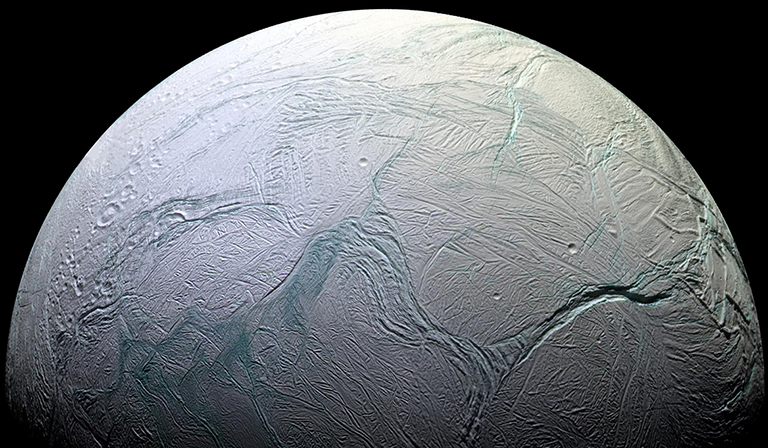 |
| from NASA - https://solarsystem.nasa.gov/missions/cassini/science/enceladus/ |
https://science.slashdot.org/story/19/11/16/192240/researcher-finally-explains-why-saturns-moon-enceladus-has-tiger-stripes
Researcher Finally Explains Why Saturn's Moon Enceladus Has 'Tiger Stripes' (sciencemag.org)
Posted by EditorDavid from the heavenly-bodies dept.
In 2005, the Cassini space probe orbited Saturn's frozen moon Enceladus to photograph "enormous jets of water ice and vapor emanating from four parallel slashes near its south pole," reports Science. "Since then, researchers have detected organic molecules and hydrogen in the jets -- potential food for microbes -- making Enceladus one of the top destinations in the search for life elsewhere in the Solar System."
But a new paper posted this week on the preprint server arXiv claims to finally understand the mystery of that moon's "tiger stripes":The stripes...are 130 kilometers long and are spaced roughly 35 kilometers apart -- rather large features on a moon only 500 kilometers in diameter. Nobody quite understood their origin, or why they were only seen at one pole...
As it orbits around Saturn, Enceladus experiences gravitational tidal forces that squeeze and heat it. Cassini data had already shown that a liquid water ocean sits underneath the outer ice shell, which is thinnest at the north and south poles. According to the new study, led by Douglas Hemingway of the Carnegie Institution for Science in Washington, D.C., as the moon cooled over time and some of the ocean water refroze, the new ice generated strain that built up in the surface until it broke. "It's like your pipes freezing on a cold day," says planetary scientist Francis Nimmo of the University of California, Santa Cruz, who was not involved in the study... That first fissure, extending down to the ocean, allowed a geyser to spray snow on its two flanks. The weight of this extra material produced more strains. In their study, the researchers calculate that these forces should have cracked additional grooves on either side, roughly 35 kilometers from the original one...
The moon's low gravity means that fractures can bust all the way through its outer shell and persist. On a more massive moon, the researchers say in their study, the weight of heavier ice would tend to squeeze cracks shut.
+++++++++++++++++++++++++++++++++++++++++++++++++++++++++++++++++++++++
+++++++++++++++++++++++++++++++++++++++++++++++++++++++++++++++++++++++
+++++++++++++++++++++++++++++++++++++++++++++++++++++++++++++++++++++++
- Bloggery committed by chris tower - 1911.17 - 10:10
- Days ago = 1597 days ago
- New note - On 1807.06, I ceased daily transmission of my Hey Mom feature after three years of daily conversations. I plan to continue Hey Mom posts at least twice per week but will continue to post the days since ("Days Ago") count on my blog each day. The blog entry numbering in the title has changed to reflect total Sense of Doubt posts since I began the blog on 0705.04, which include Hey Mom posts, Daily Bowie posts, and Sense of Doubt posts. Hey Mom posts will still be numbered sequentially. New Hey Mom posts will use the same format as all the other Hey Mom posts; all other posts will feature this format seen here.
No comments:
Post a Comment